In the list of the egregiously expensive stuff you have to buy to maintain an airplane, tires barely rise to the level of annoyance. But when the shop calls and says you need a new left main, if your reaction is, “didn’t we just do that?” you’re hardly alone. You may very well have traded your last car before it needed new tires. Why isn’t it the same with airplanes?
It’s a good question and one we recently posed to several experts in the aircraft tire industry. The answer is that airplane tires are to modern car tires as apples are to kumquats. Other than both being round-you hope-car tires and airplane tires don’t have much in common because they perform radically different jobs. Car tires have been driven relentlessly forward by competition and technology; airplane tires, not so much.
In this article, well examine the basics of aircraft tires, with an eye toward explaining why they rarely seem to last long. In a subsequent article, well again undertake the Great Florida Tire Death Match, subjecting the industry’s best rubber to a screeching, burning torture test of accelerated landings. (May the heartiest of bead and tread prevail.)
Tire Tech
The basic light aircraft tire isn’t that much different from the ones your grandparents used on their Model T. The current standards for aircraft tires are embodied in the FAAs Technical Standard Order (TSO) C62e, last revised in 2006. (The TSO only addresses tires; inner tube standards are set by the Society of Automotive Engineers.)
According to Specialty Tires of Americas Aircraft Products Manager Lee Willienbacher, the TSO process is a “torture test,” of 100 to 120 consecutive landings. A standard 6.00 x 6 tire, the same size we’ll be testing, sees 3000 pounds on it during that exercise, Willenbacher adds.
Instead of the radial-ply tires that are the standard for modern automobiles, light aircraft tires are a bias-ply design, where the internal fabric cords are sandwiched between two layers of rubber and laid diagonally-at 30- and 60-degree angles to the tires centerline-and extend from bead to bead. Additional plies are laid opposite to each other. This contrasts with a radial-ply tire, a technology widely used by larger, faster aircraft. Its based on plies laid from bead to bead but at
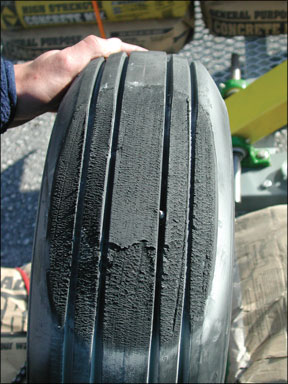
right angles to the tread. The sidebar at right provides additional detail on the differences between automotive and light-airplane tires.
All of the tires we selected for our tire tests come with six-ply ratings. That doesn’t mean they all have six fabric-and-rubber plies, however. Ply ratings don’t count the actual number of fabric or rubber layers found inside the tire, but indicate an equivalent strength based on industry standards. A tires “ply rating” is an admittedly dated method of rating the tires load capacity-automotive tires use a more realistic and up-to-date weight-based load-rating system.
These days, almost all of the fabric used in light-aircraft tires is nylon, chosen for its high-temperature characteristics, according to Richard Brown, general aviation sales and marketing manager for Goodyear Aviation Tires. Brown tells us heat is the aircraft tires most potent natural enemy; anticipating and managing the heat generated in operation is one of the tire designers key objectives. Nylon handles that heat better than other fabrics, although Goodyear does put a Kevlar belt in its Flight Custom III offering.
There’s never a free lunch, of course, which means that nylon in aircraft tires has an unintended consequence: After being parked for several days, tires take a set, becoming out of round which you notice in that washboard sensation you get taxiing out for the first flight after a couple of weeks.
Nylon has what tire engineers consider a “memory” and will temporarily conform to the tires at-rest shape. Once rolling and warmed up from the natural friction generated, nylon will relax back to its original shape. The longer you taxi before taking off, the greater chance of the tires losing their memory before the takeoff roll. More on taxi and takeoff-related heat in a moment.
Rubber Meets Runway
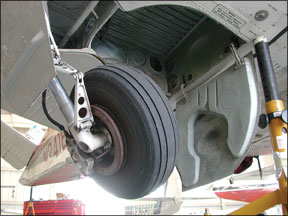
Another tire component is its tread, that part of the tire actually in contact with the ground. Two main characteristics of the tires tread are of interest to aircraft owners: the compound used and the number of grooves. The tread compounds hardness is a classic compromise. If its too soft, the tire will wear too quickly. At the other extreme, if the tread compound is too hard, wet weather performance will suffer. And so will the ride, which will tend to be noticeably hard. The mama-bear compromise strives for the best wear resistance along with good traction and wet-weather behavior.
Referring again to the cross-sections, note that most tires have at least four grooves; Goodyears Flight Custom III series has two. Goodyears Brown tells us the tread grooves serve mainly as wear indicators. “When the groove disappears, remove the tire. They provide some degree of hydroplane protection, but mostly when new,” he adds.
“Another reason for grooves is tradition. Years ago you saw all sorts of tread patterns on aircraft tires, diamonds, blocks and even smooth tires. The design of the tread eventually fell into the groove pattern seen today on all manufacturers tires,” Brown says.
Two additional characteristics deserve mention. First is the venting built into the tires. These are marked by small white (tube-type) or green (tubeless) dots painted on the sidewalls and beads. These vents allow gas trapped during the curing process and generated by natural offgassing-evaporation of volatile
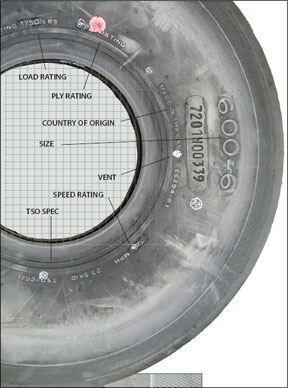
chemicals from the plies-to escape the tire. Without them, the sidewalls would develop bubbles of trapped gas.
Another characteristic has nothing to do with tires but with their inner tubes. Until recently, tubes were manufactured from a natural rubber compound. Unfortunately, natural rubber is relatively porous and loses pressure more readily than synthetic materials. Therefore, your tires would lose pressure and go soft, too.
Enter the butyl rubber tube, now largely the standard among all aircraft inner tube manufacturers. Since unused inner tubes are perfectly good for installation, were not saying you wont find a natural rubber tube out there on some shops shelf. Its perfectly serviceable, it just won’t hold air as well.
Goodyears Brown says the new butyl tubes, introduced some seven years ago, improve air retention by a factor of about 10. Steve Chlavin of Desser Tire, the GA industrys mega tire retailer, agrees, saying, “The new butyl leak-resistant tubes just don’t leak.”
Beyond the plies, tread and inner tubes are the sidewall, beads and the liner. The sidewall covers and protects the plies, basically supporting the tread portion and mounting the beads. In turn, beads are fabricated from rubber-embedded steel wire to form a bundle, seating tightly against the wheel to ensure the tire doesn’t shift during rotation. Last but not least, the liner covers the tires interior, serving as a protective barrier between the inner tube and the plies. All the tires were testing are tube-type tires, which is the accepted standard for small airplanes. In a tubeless tire-the realm of the turboprop and higher–the liner is thicker to help retain the air or nitrogen used for inflation.
How Hot Is It?
The heat a tire experiences partially results from rolling friction and sidewall flexing. Too much heat and the tire will start to fail from delamination and tread separation.
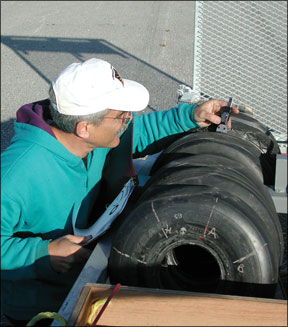
Too little heat and, as we explored in discussing nylons properties, the tire wont flex as intended. A rough ride can result, among other things. Measuring that heat is problematic, since we don’t have sensors providing that data to the cockpit. So when is the most heat generated and what can we do to minimize or manage it?
The answer is on takeoff, not landing, surprisingly. Yes, landings are stressful, but they dont generate as much heat as a taxi/takeoff cycle. At first blush it seems the stress of accelerating from zero to 60-plus knots in less than a second, then braking and taxiing would be more demanding than rolling for a while and then accelerating to a high speed. But remember, rolling friction generates heat.
Goodyears Brown again: “There’s no denying landings are stressful, but speed and heat build are greatest at the end of the takeoff roll. The aircraft is heavier than it will be for the remainder of the flight at takeoff. This is also when the tire has been rolling at maximum load and subject to the higher speed associated with the takeoff.”
Sure, landings are stressful, and tread wear is at its greatest. But Brown reminds us the aircraft weighs less during landing due to the fuel burn since takeoff. Further, it typically touches down at 60 to 80 percent of its takeoff speed. A tires touchdown spin-up occurs on a “cold” tire and at a lighter load. “Braking passes a lot of energy into the tire and some of that will be absorbed in the process, but the takeoff is still the more severe event,” Brown adds. From which we can conclude an aborted takeoff imposes the most stress on a tire? Not necessarily, responds Specialty’s Willenbacher. “The only thing with the touch and go landing is the number of impacts in short succession,” Willenbacher says. “But aircraft tires are built to take that.”
How to minimize the heat transfer? Good airmanship. Dont taxi too fast, especially if the airplane is fully loaded. Use brakes sparingly, since the heat generated by braking is transferred from the disc to the wheel and then to the tire. And, since an underinflated tire generates more friction-related heat, ensuring proper inflation is the single thing pilots can do to extend tires life.
The Air In There
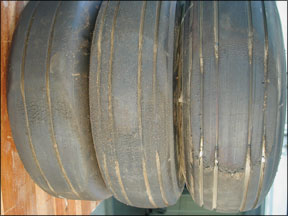
So inflation pressure is the most important variable when it comes to getting the most from tires. It’s also one of the few things pilots can control. How important is proper inflation? Goodyears Brown says its the most important thing when it comes to helping prevent premature tire failures. According to Brown, “overdeflection” or excessive deformation of a rolling tire builds heat as the sidewalls flex. Too much deflection-the industry-standard ideal is 32 percent-results in excessive heat, which can lead to separation and tire failure. And overdeflection is directly related to underinflation. Even when properly aired up, an aircraft tire can appear underinflated.
Brown says the modern light-aircraft tire will look underinflated even when its carrying the proper pressure. Further, overinflation-within reason-is preferable to underinflation. “As long as the rated inflation pressure isn’t exceeded, the tire will be okay,” says Brown of overinflation.
Speciality’s Willenbacher agrees, telling us, “Keeping proper inflation pressure is vital. Underinflation will wear the tire prematurely.” He adds that most people don’t even check their car tires enough, and then perhaps only when heading out on a trip. Keeping the tire properly inflated, he adds, will help prolong its life, ensuring more even wear. “I don’t know anyone who checks their tires inflation often enough,” Willenbacher concludes.
But what is the proper inflation for an airplane tire? The answer isn’t molded into the sidewall; that value is the maximum rated pressure. Instead, the proper inflation pressure is found in the airplanes POH/AFM and is determined by the airframe manufacturer, not the tire maker. As long as the proper size and ply-rating tire is installed, inflate the tire per the recommendations listed in the airplanes POH/AFM. Check the tires cold and use a good-quality gauge. That’s basically it.
In our next report, well have the results of our tire testing. We’ll be putting 11 of general aviations most popular tires through multiple simulated landings, plus taxi trials. Well also take a close look at popular inner tubes, comparing their weight, size and air retention. And well drag out the same tires used in 2004-we never throw anything away-to examine how they’ve coped during four years in Florida’s harsh climate.


